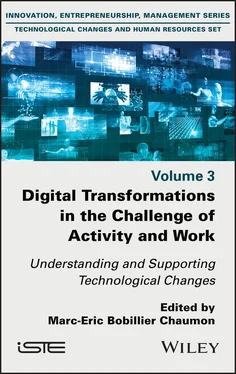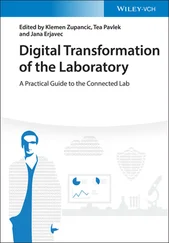Digital Transformations in the Challenge of Activity and Work
Здесь есть возможность читать онлайн «Digital Transformations in the Challenge of Activity and Work» — ознакомительный отрывок электронной книги совершенно бесплатно, а после прочтения отрывка купить полную версию. В некоторых случаях можно слушать аудио, скачать через торрент в формате fb2 и присутствует краткое содержание. Жанр: unrecognised, на английском языке. Описание произведения, (предисловие) а так же отзывы посетителей доступны на портале библиотеки ЛибКат.
- Название:Digital Transformations in the Challenge of Activity and Work
- Автор:
- Жанр:
- Год:неизвестен
- ISBN:нет данных
- Рейтинг книги:4 / 5. Голосов: 1
-
Избранное:Добавить в избранное
- Отзывы:
-
Ваша оценка:
- 80
- 1
- 2
- 3
- 4
- 5
Digital Transformations in the Challenge of Activity and Work: краткое содержание, описание и аннотация
Предлагаем к чтению аннотацию, описание, краткое содержание или предисловие (зависит от того, что написал сам автор книги «Digital Transformations in the Challenge of Activity and Work»). Если вы не нашли необходимую информацию о книге — напишите в комментариях, мы постараемся отыскать её.
Digital Transformations in the Challenge of Activity and Work — читать онлайн ознакомительный отрывок
Ниже представлен текст книги, разбитый по страницам. Система сохранения места последней прочитанной страницы, позволяет с удобством читать онлайн бесплатно книгу «Digital Transformations in the Challenge of Activity and Work», без необходимости каждый раз заново искать на чём Вы остановились. Поставьте закладку, и сможете в любой момент перейти на страницу, на которой закончили чтение.
Интервал:
Закладка:
These mechanisms are supposed to facilitate the articulation of professionals among themselves, in order to better manage meetings and the structuring, capitalization and dissemination of knowledge, based on the information they hold in a professional or personal capacity. Thus, the functionalities of DESNs offer to these professionals dispersed within the company ( belonging to different teams or projects and professions ), the ability to jointly write documents in an asynchronous way, using different formats ( wiki pages, publishing of documents, posting comments ), to express a point of view or an opinion using interactional functionalities ( like, get in touch, subscribe to a group ), and to interact with a group of actors dispersed within the company ( belonging to different teams or projects and professions ), to work together on common subjects.
2.2.2. Mobilizing social capital to make sharing more flexible
Social capital is defined as the set of relationships that can be mobilized by an individual or a group and can be considered to be a resource that is comparable to economic capital. It is based on a principle of solidarity that makes it possible to give information to colleagues. It is based on cooperation dynamics that exist outside of formal procedures (Bourdieu 1980; Alter 2009).
In these cross-functional, asynchronous and multi-professional work contexts, the manager’s role as an arbitrator tends to disappear. This translates into a net increase in the decision-making autonomy of the employee, who must then develop new, less cognitive and more relational skills ( self-esteem, social skills, decision-making autonomy, also known as “soft skills” ). Indeed, not only must one learn and acquire knowledge, but also learn to cooperate in order to work in a group according to the specific modalities of social networks: to show oneself on the network, to know how to manage one’s visibility and to organize one’s interactions and presence (Cardon 2008). Professionals are then enjoined to show flexibility and reactivity by mobilizing their social capital (Lazega 2006) via DESN functionalities that promote social and interactive ( interacting, posting a comment ) and cognitive ( problem solving ) dimensions in mediatized collaborative environments (Détienne et al . 2010). The objective is to develop innovation and social links, to improve production quality and to capitalize knowledge (Galinon-Mélénec 2010; Conaldi and Lomi 2013).
Finally, the DESN is more than just a technology. It becomes a collaborative partner in the service of value creation that stems from all the networking and co-configuration mechanisms in which professionals can participate. However, from the point of view of work activity, these mechanisms pose major challenges for professionals. We are witnessing a loss of the centrality of activities and a reconfiguration of the conditions surrounding the power to act.
2.3. Stakes for the development of activity: knowing how to give meaning to a poly-contextual and multi-mediated activity
Poly-contextuality is defined by a multiplication of socio-organizational (several types of organization within a company), professional (several professions) and instrumental (several means of interaction with DESNs and several mobilized ICTs) contexts. It is the main characteristic of contemporary activities carried out via these socially oriented technologies. In these variable, labile and flexible activities, the possibility of identifying “ what must be done, how and for whom ” participates in this sense of usefulness that is considered a priority in the construction of meaning in work. We can then wonder about the ability, of a professional immersed in these poly-contextual activities, to clearly identify the work objects that need to be carried out in order to orient the activity in these work environments and give meaning to their work (Sannino et al . 2009).
2.3.1. Networking, the power to act and meaning at work
2.3.1.1. Activity, an organized and dynamic system
In the field of work, the development of a sufficiently good activity is a health operator (Clot 2008). Human activity is characterized by the capacity of individuals and collectives to develop strategies with artifacts (to appropriate them) in order to be able to act on the environment around them. Work activity can therefore be considered as the result of a system of interactions produced between several human and non-human actors (artifacts, norms, rules, tools, technical objects) and which makes it possible to achieve objectives (see Figure 2.1).

Figure 2.1. The activity system (Engeström 1998)
The subject will therefore configure and adapt their environment (material and technical) and its uses in new practices so that they correspond to their needs, intentions and motivations (Rabardel 1995). The activity must be considered as the result of the organization and permanent renegotiation that the actor produces, between these different extremes, to give meaning to their activity. According to this model, the individual can only carry out their action through systems of collective activity, where skills are developed, supported by practices validated by the group. We then speak of two mechanisms that are induced by mediatized activity: taking ownership of changes that come from outside (i.e. learning ) (Rabardel 2005), and being able to act within the environment with the help of acquired knowledge (i.e. developing skills ) (Bobillier Chaumon and Clot 2016). Thus, the power to act is defined as the effective range of actions that the individual or groups are capable of implementing, given a certain degree of re-creation of the environment (Bobillier Chaumon 2017). It also makes it possible to qualify the efficiency and dynamism of the activity.
2.3.1.2. Network activity, the reign of negotiation in work
Professionals using DESNs engage in a poly-contextual activity where different activity streams are managed in parallel, based on different work objects that may be juxtaposed or diametrically opposed (Engeström et al . 1995). The goals and means to carry out this activity are systematically different, involving collectives that often do not belong to the same profession, for purposes that may vary according to the people involved and the service objectives (Engeström 2008a).
The actor thus combines several activity systems that are constantly being impacted by the intentions and expectations of their colleagues, the effects of the division of labor and the tools used, as well as their own motivations and needs. The complexity is then to manage to articulate a professional practice that makes sense by “ knitting ” thier daily activity at the intersection of several activity systems and networks. This “ knitting ” makes it possible to formalize this extremely rapid, flexible and efficient mode of action (“ knots ”), which frees itself from the usual spaces and rules of operation, to focus on the moment and concrete needs. These “ knots ” correspond to the orchestration of a collective, distributed and partially improvised performance between actors or systems of activity that are otherwise weakly connected to each other (Engeström 2008a) (see Figure 2.2).

Интервал:
Закладка:
Похожие книги на «Digital Transformations in the Challenge of Activity and Work»
Представляем Вашему вниманию похожие книги на «Digital Transformations in the Challenge of Activity and Work» списком для выбора. Мы отобрали схожую по названию и смыслу литературу в надежде предоставить читателям больше вариантов отыскать новые, интересные, ещё непрочитанные произведения.
Обсуждение, отзывы о книге «Digital Transformations in the Challenge of Activity and Work» и просто собственные мнения читателей. Оставьте ваши комментарии, напишите, что Вы думаете о произведении, его смысле или главных героях. Укажите что конкретно понравилось, а что нет, и почему Вы так считаете.












